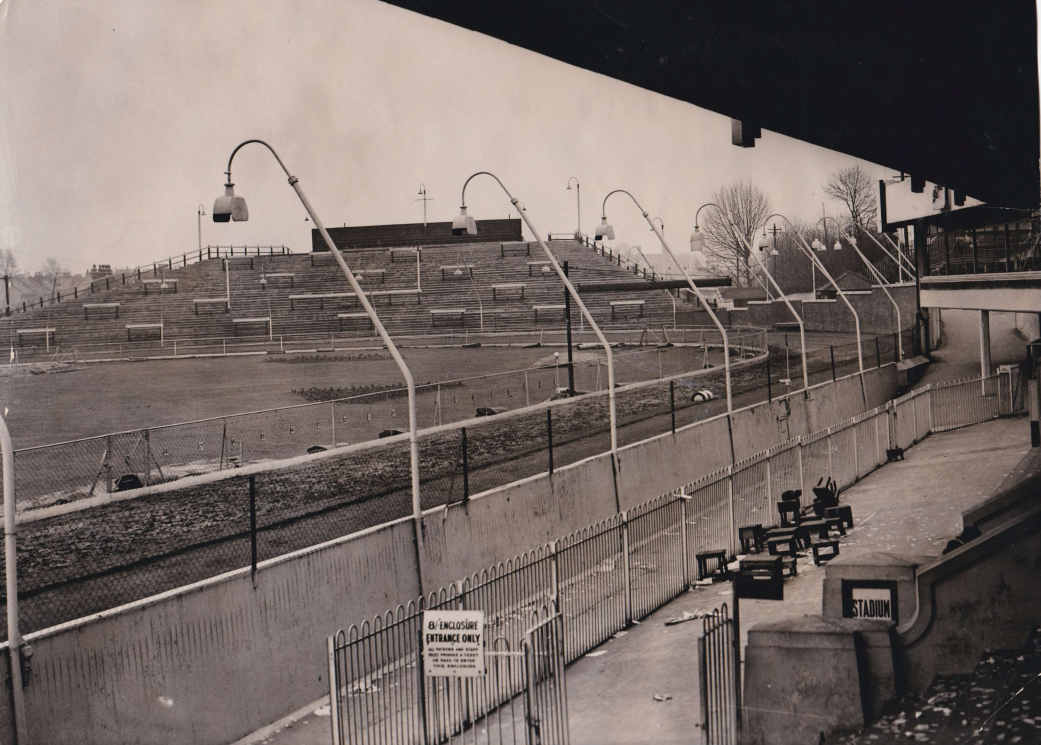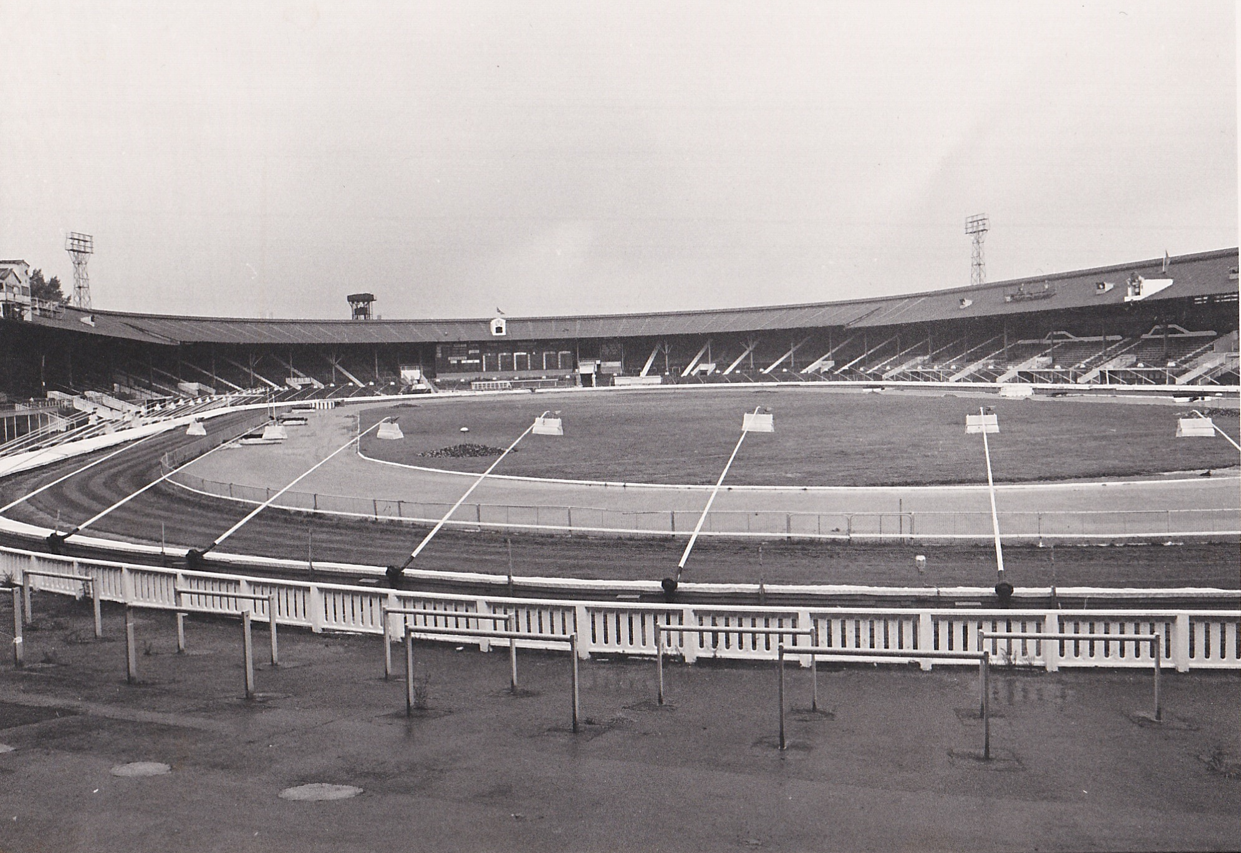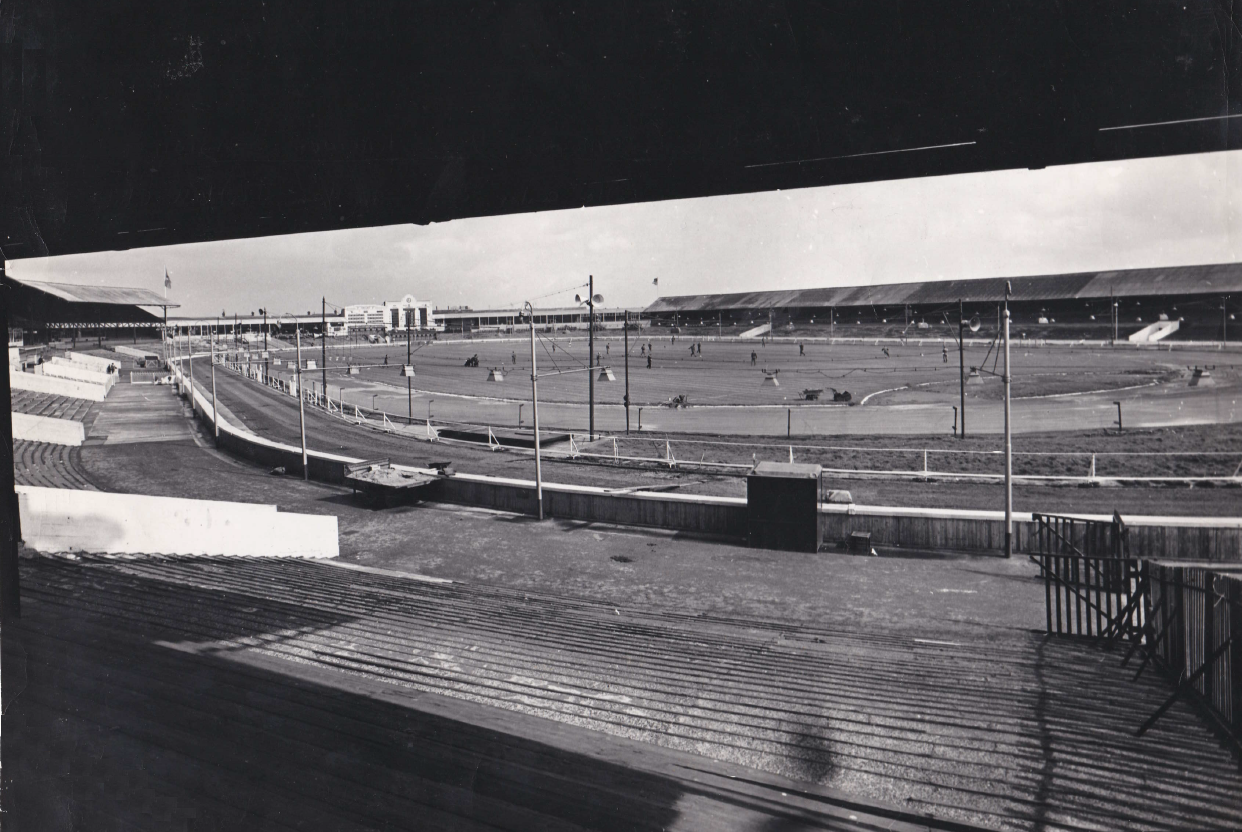|
Greenwich Cup
The Greenwich Cup was a greyhound racing competition held annually from 1946 until 2003. It was inaugurated in 1946 at New Cross Stadium but following the closure of New Cross in 1969 it switched to Charlton Stadium. It only survived two years at Charlton because it also closed and the race found its final home at Catford Stadium in 1972. When the Greyhound Racing Association shut down Catford in 2003 the race was discontinued. Past winners Venues & Distances *1946-1964 (New Cross 415 yards) *1965-1968 (New Cross 600 yards) *1969-1970 (Charlton 600 yards) *1972-2003 (Catford 555 metres) Sponsors *1987-2000 E.Coomes Bookmakers *2001-2001 Brake Bros Brakes (previously known as ‘Brake Bros Ltd’) is a food and distribution company supplying food, drink and other products mainly to the catering industry in the UK through more than 20 distribution centres. It provides delivered wholesale ... *2002-2003 William Hill References {{UK & Irish greyhound competitions Gre ... [...More Info...] [...Related Items...] OR: [Wikipedia] [Google] [Baidu] |
Catford Stadium
Catford Stadium was a historic greyhound racing stadium in Catford, a suburb of London. Origins Charles Benstead and Frank Sutton founded the stadium on Southern Railway land between two commuter lines in 1932. The entrance was on Adenmore Road, West of Doggett Road. Greyhound Racing Opening The inaugural meeting was held on Saturday 30 July 1932 and consisted of a seven card race of events comprising four or five runners. Mick the Miller was paraded around the track prior to the fourth race. The first racing manager was Lt. Col. A J Vernon and there were no less than eighty bookmakers. A kennel complex was constructed at Layham's Farm, Keston, near Biggin Hill and six trainers were appointed. The track was described as a tight 369 yard circumference circuit and the hare was an 'Outside Breco Silent' before being switched to a more conventional 'Outside McKee'. Buses originally dropped patrons off just outside the main gates and by the entrance gates were tote facilities a ... [...More Info...] [...Related Items...] OR: [Wikipedia] [Google] [Baidu] |
1955 UK & Ireland Greyhound Racing Year
The 1955 UK & Ireland Greyhound Racing Year was the 30th year of greyhound racing in the United Kingdom and Ireland. Roll of honour Summary Spanish Battleship became the greatest greyhound in Irish history by securing a third consecutive Irish Greyhound Derby title. No other greyhound had managed to win more than one Irish Derby previously. Before retiring, he broke the track record at Cork during his Laurels victory and won another McCalmont Cup title. His connections turned down a £15,000 bid from a London syndicate. Rushton Mac defeated the versatile and hot favourite Barrowside in the English Greyhound Derby final. Competitions Barrowside dominated the Grand National at White City, the red fawn dog claimed a five length victory at odds of 1-3 in a track record time of 29.43. The Gold Collar at Catford Stadium was won by Firgrove Slipper, a competition that featured 1953 English Greyhound Derby champion Daws Dancer. The new Derby champion Rushton Mac won the Welsh Greyhoun ... [...More Info...] [...Related Items...] OR: [Wikipedia] [Google] [Baidu] |
1963 UK & Ireland Greyhound Racing Year
The 1963 UK & Ireland Greyhound Racing Year was the 37th year of greyhound racing in the United Kingdom and Ireland. Roll of honour Summary The Greyhound Afternoon Service was established whereby tracks supplied afternoon racing for the larger bookmaking clients. However the track promoters made a request for a guaranteed payment for the off course rights from all bookmakers taking bets from their stadium. Negotiations would continually take place between the stadiums, the National Greyhound Racing Society (NGRS) and the bookmakers. The problems had been ongoing since the introduction of the Betting and Gaming Act 1960. Clapton Stadiums Ltd owners of Clapton Stadium, Slough and Reading scrapped evening starting times in an attempt to disrupt the betting in bookmaker's shops. Tracks racing during the afternoon had already implemented this procedure. A further development resulted in the tracks ending the annual £100,000 agreement with the off course bookmakers to provide forecas ... [...More Info...] [...Related Items...] OR: [Wikipedia] [Google] [Baidu] |
1962 UK & Ireland Greyhound Racing Year
The 1962 UK & Ireland Greyhound Racing Year was the 36th year of greyhound racing in the United Kingdom and Ireland. Roll of honour Summary The decrease in attendances continued as a result of the Betting and Gaming Act 1960, which contributed to more track closures. Boundary Park Stadium in the Hellesdon area of Norwich closed on 1 December 1962, to become a redeveloped site for the Eastern Electricity Company. Rochdale switched to independent status and Charlton Stadium closed after difficulties (it would re-open four years later however), in the meantime their top event the Cloth of Gold would take place at Wandsworth Stadium. English Greyhound Derby finalist Dromin Glory, a brindle dog trained by John Bassett had a brilliant year winning both the Scottish Greyhound Derby and Cesarewitch at West Ham Stadium in consecutive months. This was achieved in addition to lifting the Birmingham Cup, Gymcrack and Select Stakes and was voted Greyhound of the Year. Competitions The G ... [...More Info...] [...Related Items...] OR: [Wikipedia] [Google] [Baidu] |
1961 UK & Ireland Greyhound Racing Year
The 1961 UK & Ireland Greyhound Racing Year was the 35th year of greyhound racing in the United Kingdom and Ireland. Roll of honour Summary The Betting and Gaming Act 1960 came into force on 1 January 1961. The effect was almost instantaneous with afternoon attendances collapsing. In an attempt to combat the decline, the National Greyhound Racing Society banned telephones at the track and did not allow results to be published before 9.00 pm. In addition they attempted delaying trap draws and enforced a copyright on the tote returns but the government legislation had effectively handed over the afternoon track trade to the bookmaker industry. Bizarrely the government handed horse racing a levy (a deduction from bookmaker's turnover that would be paid back to the racecourses), under the Betting Levy Act 1961. The levy was given because of the losses that horse racing would incur with daytime bookmakers shops opening. Greyhound racing was not given a levy which came as a furth ... [...More Info...] [...Related Items...] OR: [Wikipedia] [Google] [Baidu] |
White City Greyhounds
White City Greyhounds was the greyhound racing operation held at White City Stadium in London. The venue was regarded as the sport's primary track during its existence. History Origins After the 1908 Summer Olympics the White City area was used for further exhibitions, including the France-Britain Exhibition of 1908 and the Japan-Britain Exhibition of 1910, but the stadium began to be underused. By 1922 attempts had been made to sell it and it is reputed to have been in a very poor state by 1926. During the Februarys of 1926 and 1927 the stadium was used for the British Industries Fair before the public announcement that the Greyhound Racing Association (GRA) had purchased the stadium following on from the success experienced by the company at the nation's first greyhound meetings in Manchester at Belle Vue Stadium. It would be the GRA's second stadium and the old running and cycle tracks were grassed over. A new restaurant was built and covered terracing was constructed. The ... [...More Info...] [...Related Items...] OR: [Wikipedia] [Google] [Baidu] |
1960 UK & Ireland Greyhound Racing Year
The 1960 UK & Ireland Greyhound Racing Year was the 34th year of greyhound racing in the United Kingdom and Ireland. Roll of honour Summary The National Greyhound Racing Club released the 1960 figures for their affiliated tracks, which showed that 14,243,808 paying customers attended 5,736 meetings. The totalisator turnover was £54,188,302 but government tote tax remained at 10% with track deductions remaining at 6%. Turnover and attendances remained stable but one piece of government legislation was about to have a dramatic impact on the industry. The Betting and Gaming Act 1960 was passed on 1 September 1960 and would come into effect four months later, on 1 January 1961. Tracks Staines Greyhound Stadium closed, forcing Jack Walsh to open a bookmakers shop in Egham, Surrey, Walsh had been part owner with William Hill of the 1938 English Greyhound Derby winner Lone Keel. Gerry Bailey and Jack Carter took over the lease at Rye House Stadium from the Lea Valley Regional Pa ... [...More Info...] [...Related Items...] OR: [Wikipedia] [Google] [Baidu] |
Walthamstow Stadium
Walthamstow Stadium was a greyhound racing track in the London Borough of Waltham Forest in east London.BBC News - Walthamstow race track to close' It was regarded as the leading greyhound racing stadium in Britain following the closure of White City in 1984. The stadium closed on 16 August 2008. Greyhound racing Crooked Billet In the early part of the 20th century the Myrtle Grove sports ground was built and used by the Walthamstow Grange Football Club from 1908. By 1929 the ground hosted greyhound racing for the first time and was known as the Crooked Billet Greyhound and whippet track (named after the nearby Crooked Billet public house). The track was an independent track, unaffiliated to a governing body. In 1931, William Chandler, a bookmaker by trade, decided to build on the existing independent track. Chandler also had shares in the Hackney Wick Stadium. Opening It cost Chandler £24,000 to buy the site and the Art Deco parapet entrance was built in 1932 with the c ... [...More Info...] [...Related Items...] OR: [Wikipedia] [Google] [Baidu] |
1959 UK & Ireland Greyhound Racing Year
The 1959 UK & Ireland Greyhound Racing Year was the 33rd year of greyhound racing in the United Kingdom and Ireland. Roll of honour Summary Mile Bush Pride was voted Greyhound of the Year after becoming only the second greyhound, after Trev's Perfection to win the Triple Crown which consisted of the English Greyhound Derby, Scottish Greyhound Derby and Welsh Greyhound Derby. Trained by Jack Harvey for owner Noel Purvis, a shipping magnate, the brindle greyhound also won the Pall Mall, Select Stakes and Cesarewitch in 1959. Competitions Irish Greyhound Derby champion Colonel Perry moved kennels from John Bassett to Tom Baldwin and finished a disappointing fourth in the final of the Gold Collar behind Dunstown Warrior. After his English Greyhound Derby success, Mile Bush Pride ran out an eleven and a quarter winner of the Welsh Derby, in 28.80 seconds, eclipsing the previous track record by over five lengths. Mile Bush Pride then achieved the Triple Crown by winning the Scotti ... [...More Info...] [...Related Items...] OR: [Wikipedia] [Google] [Baidu] |
West Ham Stadium
West Ham Stadium was a stadium that existed between 1928 and 1972 in Custom House, in East London (it was in the County Borough of West Ham, in the county of Essex, at the time of the stadium's construction). The stadium was built in 1928 on Prince Regent Lane, near the site of the present-day Prince Regent DLR station. The venue was used for greyhound racing and speedway on weekdays and had no connection with West Ham United football club, who played at the nearby Boleyn Ground, Upton Park from 1904 until 2016. Greyhound racing Origins Plans for a very large stadium in a rural area near Plaistow Marsh, east of Canning Town were unveiled in the late 1920s and work began on the structure where an old sports ground (built in 1855) was situated that had belonged to the workers of the custom house of Royal Victoria Dock. The stadium was designed by Archibald Leitch, responsible for most of the major football stadia at the time including Anfield and Highbury. There was a large t ... [...More Info...] [...Related Items...] OR: [Wikipedia] [Google] [Baidu] |
1958 UK & Ireland Greyhound Racing Year
The 1958 UK & Ireland Greyhound Racing Year was the 32nd year of greyhound racing in the United Kingdom and Ireland. Roll of honour Summary The National Greyhound Racing Society (the management branch of the National Greyhound Racing Club agreed a deal with the BBC to provide an annual greyhound event which would be shown live on Sportsview. The race would be known as the Sportsview BBC Television Trophy with the venues to be changed each year. The first competition was at Wimbledon over 500 yards but it was soon discovered that the distance was too short for the viewers to remain interested, which resulted in a switch to longer distances the following year. The inaugural event was claimed by trainer Leslie Reynolds with a 20-1 shot called Town Prince. Pigalle Wonder was voted Greyhound of the Year, after a year that included winning the 1958 English Greyhound Derby at White City, Cesarewitch at West Ham Stadium and Pall Mall Stakes at Harringay Stadium. Competitions Pig ... [...More Info...] [...Related Items...] OR: [Wikipedia] [Google] [Baidu] |
1957 UK & Ireland Greyhound Racing Year
The 1957 UK & Ireland Greyhound Racing Year was the 31st year of greyhound racing in the United Kingdom and Ireland. Roll of honour Summary Marsh Barton Stadium in Exeter closed; many smaller independent tracks were susceptible to closure, mainly due to the fact that government taxing of tote profits outweighed the income from attendances. This was leaving many of them untenable. Regulated tracks under the National Greyhound Racing Club (NGRC) banner were better off and remained successful, with annual tote turnover still around £55 million. The Greyhound Racing Association (GRA) continued to be the most successful greyhound company (as it had been every year since the introduction of racing in 1926). The Chairman Francis Gentle announced that net profits had increased to £119,000 but the sale of Harringay Arena had been agreed because it was operating at a loss. It was sold to the Home and Colonial Stores Ltd. Gentle remains Chairman of the company but relinquishes his ro ... [...More Info...] [...Related Items...] OR: [Wikipedia] [Google] [Baidu] |



